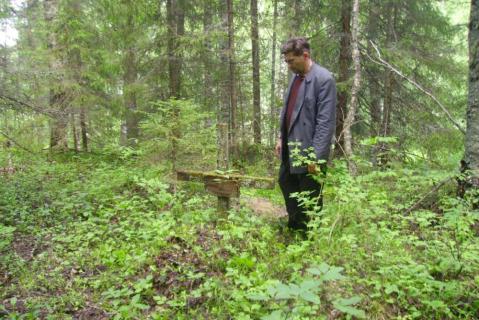The Chesel labour settlement was organised in 1930 by dekulakised peasant families, deported from Belarus and the southern parts of Russia. Among them were Catholics, including ethnic Poles. In 1940, Polish citizens deported from the newly annexed western regions of Ukraine and Belarus were sent to Chesel. There were, it seems, two graveyards: an Orthodox burial ground (not discovered) and a Catholic graveyard which lies 500 metres from Chesyel on the high bank of the Luza river. The total numbers of men, women and children buried there have not been established: the names of only ten Polish citizens who died in Chesel are known. In August 1941 the special regime was lifted and the Poles gradually departed.
In the mid-1950s the settlement ceased to exist and both graveyards were abandoned. The burial site was discovered and studied in summer 2007 by an expedition of pupils from the Letskaya secondary school (director V.M. Masaltsev). A wooden Catholic cross has survived on one of the graves with a board bearing the letters “…nski Kazimierz, 1869-1940” in Polish.
Repentance: the Komi Republic Martyrology of the Victims of Mass Political Repression (11 vols. 1998-2016), includes entries on 65,000 individuals, from dekulakised peasant families and former Polish citizens to Soviet German forced labourers, who were deported to the area.
The Memorial online database (2025) lists 129,473 victims in the Komi Republic. (See Nizhny Chov.)
Among them were over 64,000 deportees sent to or born in the Republic. During collectivisation (1929-35) they numbered 20,366, a quarter of whom were aged 1-10. In 1940 there was a massive influx from occupied Polish territory (19,367). More, mainly Germans (5,970) were sent in the 1940s and 1950s (6,699).
The database names 253 individuals who were deported to Chesel with their families from 1930 onwards (228) or who were born there (45).
| State of burials | Area | Boundaries |
|---|---|---|
|
burial mounds (15-20 burials) can be seen; a western grave cross has survived
|
about 2,500 square metres
|
not delineated
|
[ Original texts & hyperlinks ]
Materials of the school expedition (Letskaya village, Priluzsky district, Komi republic), compiler V.M. Masaltsev – Pokayanie Foundation Archive (Syktyvkar)
“Chesel special settlement. Deportees graveyard”, Virtual Museum of the Gulag [retrieved, 27 May 2022; no longer accessible]

